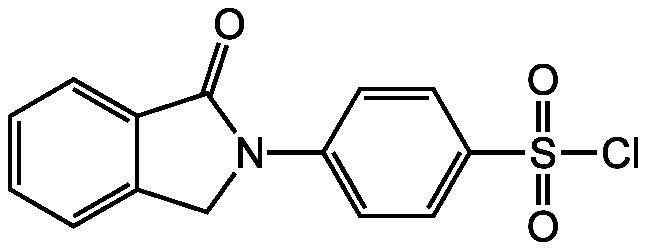Physil chloride
Product Code:
CDX-P0009
CDX-P0009
Regulatory Status:
RUO
RUO
Shipping:
Ambient
Ambient
Storage:
+4 °C
+4 °C
No additional charges, what you see is what you pay! *
| Code | Size | Price |
|---|
| CDX-P0009-M050 | 50 mg | £67.00 |
Quantity:
| CDX-P0009-M250 | 250 mg | £157.00 |
Quantity:
Prices exclude any Taxes / VAT
Stay in control of your spending. These prices have no additional charges, not even shipping!
* Rare exceptions are clearly labelled (only 0.14% of items!).
* Rare exceptions are clearly labelled (only 0.14% of items!).
Multibuy discounts available! Contact us to find what you can save.
This product comes from: Switzerland.
Typical lead time: 7-10 working days.
Contact us for more accurate information.
Typical lead time: 7-10 working days.
Contact us for more accurate information.
- Further Information
- Documents
- References
- Related Products
- Show All
Further Information
Alternate Names/Synonyms:
4-(N-Phthalimidyl)-benzenesulfonyl chloride
Appearance:
Solid.
CAS:
114341-14-9
EClass:
32160000
Form (Short):
liquid
GHS Symbol:
GHS07
Handling Advice:
Protect from light and moisture.
Hazards:
H315, H319, H335
InChi:
InChI=1S/C14H10ClNO3S/c15-20(18,19)12-7-5-11(6-8-12)16-9-10-3-1-2-4-13(10)14(16)17/h1-8H,9H2
InChiKey:
PKWBLDDSBFCSPX-UHFFFAOYSA-N
Long Description:
Chemical. CAS: 114341-14-9. Formula: C14H10ClNO3S. MW: 307.75. Synthetic. It is known that phenol and p-cresol are promoters of skin tumors and also urinary excretion of phenol and p-cresol is increased by exposure to benzene, which has hemopoietic toxicity, and toluene, respectively. Therefore, the determination of phenol and p-cresol is important in clinical chemistry and toxicology. Because phenol and p-cresol are present in urine as sulfate or glucuronide conjugates, they are hydrolyzed enzymatically or with acid, followed by distillation or extraction with organic solvent prior to measurement by GC or HPLC. However, these GC and HPLC methods require relatively large sample volumes (more than 1 ml) because of their insufficient sensitivities for measuring small amounts of phenol and p-cresol. The application of fluorescent labeling techniques to HPLC result in a sensitive and selective method. Phthalimidylbenzenesulfonyl chlorides habe also been successfully used for high sensitivity labelling of amino acids prior to HPLC.
MDL:
MFCD00674897
Molecular Formula:
C14H10ClNO3S
Molecular Weight:
307.75
Package Type:
Vial
Precautions:
P261, P305, P351, P338
Product Description:
It is known that phenol and p-cresol are promoters of skin tumors and also urinary excretion of phenol and p-cresol is increased by exposure to benzene, which has hemopoietic toxicity, and toluene, respectively. Therefore, the determination of phenol and p-cresol is important in clinical chemistry and toxicology. Because phenol and p-cresol are present in urine as sulfate or glucuronide conjugates, they are hydrolyzed enzymatically or with acid, followed by distillation or extraction with organic solvent prior to measurement by GC or HPLC. However, these GC and HPLC methods require relatively large sample volumes (more than 1 ml) because of their insufficient sensitivities for measuring small amounts of phenol and p-cresol. The application of fluorescent labeling techniques to HPLC result in a sensitive and selective method. Phthalimidylbenzenesulfonyl chlorides habe also been successfully used for high sensitivity labelling of amino acids prior to HPLC.
Purity:
>98% (HPLC)
Signal word:
Warning
SMILES:
ClS(=O)(=O)C1=CC=C(C=C1)N1CC2=CC=CC=C2C1=O
Solubility Chemicals:
Soluble in acetone.
Source / Host:
Synthetic.
Transportation:
Non-hazardous
UNSPSC Category:
Fluorescent Reagents
UNSPSC Number:
41105331
Use & Stability:
Stable for at least 2 years after receipt when stored at +4°C.
Documents
References
(1) Y. Tsuruta et al.; Anal. Biochem. 243, 86 (1996) | (2) Y. Tsuruta et al.; J. Chromatogr. 502, 178 (1990) | (3) O.M. Bakke et al.; Toxicol. Appl. Pharmacol. 16, 691 (1970) | (4) C.N. Ong et al.; J. Chromatogr. 660, 1 (1959) | (5) R. Boutwell et al.; Cancer Res. 19, 413 (1959)
Related Products
| Product Name | Product Code | Supplier | M-Phisyl-chloride | CDX-M0004 | Chemodex | Summary Details | |||||||||||||||||||||||||||||||||||||||||||||||||||||||||||||||||||||||||||||||||||||||||||||
|---|---|---|---|---|---|---|---|---|---|---|---|---|---|---|---|---|---|---|---|---|---|---|---|---|---|---|---|---|---|---|---|---|---|---|---|---|---|---|---|---|---|---|---|---|---|---|---|---|---|---|---|---|---|---|---|---|---|---|---|---|---|---|---|---|---|---|---|---|---|---|---|---|---|---|---|---|---|---|---|---|---|---|---|---|---|---|---|---|---|---|---|---|---|---|---|---|---|---|---|



